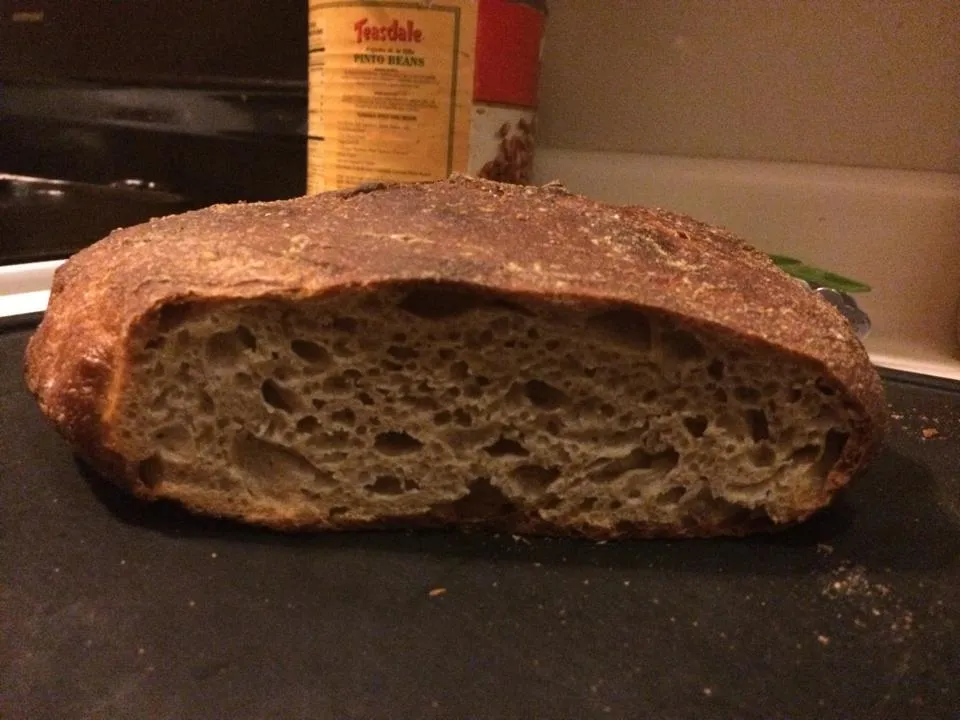
Hi all. This is my fourth try making bread using Michael Pollan's sourdough method from his recent "Cooked" book. Here's a good rundown of the recipe I am using.
They have been coming out OK. Not quite as sour as I'd like, and not enough oven spring. The loaves are kinda flat.
Also I cannot for the life of me get the loaf to not stick to my proofing baskets. I've tried dusting with flour, someone suggested spraying with oil and then dusting with rice flour, no joy. If i apply too much flour to the banneton will it smooth out the decorative rings?
Thanks for your help!
~Christine
I looked over the formula and Mr. Pollan's loaf is quite advantageous. It's heavy on the whole grains and the hydration making for a dough that will ferment rather fast and can be tricky to handle. Sound like it could make for a very tasty loaf.
First off I'd suggest not proofing the dough shaped overnight for this type of loaf. It's certainly doable but I think it would be best to either do it all in one day or retard the whole dough overnight. Cold bulk fermentation would be the route I would go with. Your loaf looks pretty good all things considered and I think is just a bit lacking in strength and/or overproofed. I'll give you two outlines I think could work.
1 day:
Follow same process as in previous recipe but during the 4 hour bulk ferment I suggest giving the dough folds every 15-20 minutes during the first hour to build more initial strength. Following that give folds every hour. Now I suggest going to youtube and watching some videos on preshape an shaping dough as written descriptions don't work well. Once shaped preheat your oven, and cast iron if using, and proof dough for 1-2 hours (depends how warm the dough is and your space). With such whole grains I'd be looking for 160-170^ rise before loading in the oven. You don't want to be quite doubled as you want to get them in the heat while still on the rise. Follow previous baking instructions and see if that helps. (Dusting your proofing bowl with a mixture of ap and rice flour helps a great deal with sticking)
2. Cold Bulk .
Follow the same protocol but after the first hour of bulk fermentation and the first hours worth of folds are done cover with plastic wrap and place in the fridge for 12-24 hours.
Remove from fridge and do your preshape but instead of a short rest let the dough sit for about an hour. You want to see it wake up. It will relax a bit and spread but if it spreads too much and feels very weak you can repeat this step to build more strength. Now shape and place in a bowl and proof 2-3 hours (the dough is cold it will take longer) Bake remains the same.
A couple things to note. You are gonna want a very vigorous starter for this task. Be sure it's been refreshed a few times before the final levain is made.
The water temperature could be dangerous. You want a final dough temp in the 76-80 F range but that very warm water could be making for a very warm dough.
Josh
Hey Josh,
thank you for that thorough reply. What I had been doing is the retarded cold ferment in the proofing baskets. I like your idea of doing it in bulk. Your suggestion for more frequent folds makes sense too, as I'd heard low spring is a gluten strength issue.
will report back next week,
christine
I just mixed up a batch of MP's bread and was browsing through postings on this when I read about your experience. Did you have better luck with the cold ferment?
K
Can someone post the leaven ingredients to pollen's bread. I borrowed the book from the library awhile ago and hand wrote the recipe. The top part of my recipe got torn off....I love this recipe. I have the dough ingredients, but not the leaven. Thanks everyone!!,